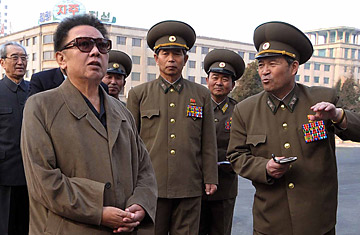
North Korean leader Kim Jong Il
Though older now, and a bit infirm, and increasingly consumed with thoughts of passing on to his youngest son the family business (running North Korea into the ground), Kim Jong Il still has a fondness for a decent Fourth of July fireworks show. Pyongyang shot at least seven short-range SCUD missiles in the direction of the Sea of Japan on Saturday morning, in what some analysts termed an act of "defiance" against the United States and its allies in east Asia. But the SCUDS, fired from the eastern coast of North Korea, have limited range, and fell harmlessly into the sea less than 300 miles (480 kilometers) from where they were launched. The exercise drew perfunctory condemnations from the U.S. and some of the North's neighbors. Indeed, "acts of defiance" have become so predictable with Kim that they've come to be business as usual. The chief of the U.S. naval forces, Admiral Gary Roughhead, meeting with Japanese counterparts in Tokyo Saturday morning, blandly observed that American and allied ships in the region were simply "tracking the missiles" and "observing the activities that are going on."
The low-key response was entirely appropriate, given Kim's past behavior on the big U.S. holiday. On July 4 2006, he test fired — unsuccessfully, it turned out — a long-range, multi-stage ballistic missile, in explicit defiance of a U.N. resolution. By comparison, today's exercise felt a bit like a teenager tossing a few M-80s into the water off a dock somewhere. (See pictures of North Koreans at the polls.)
The U.S. and the rest of the world know well that the North has a range of missiles. The Obama Administration, in the wake of Kim's recent, relentless belligerence, has made it clear that preventing the proliferation of missiles and other weapons of mass destruction is what drives U.S. policy now. On June 30, the Administration imposed unilateral U.S. sanctions on two North Korean companies engaged in proliferation — sanctions that will "augment efforts to curtail the North Korean regime's ability to develop and sell WMD and missiles," says Bruce Klingner, former North Korea analyst at the CIA, now a senior fellow at the Heritage Foundation in Washington. One of the firms sanctioned, called Hong Kong Electronics and located on Kish Island, Iran, is alleged to have transferred millions of dollars of proliferation-related funds from Iran to North Korean companies already on U.S. and U.N. sanctions lists, according to the Treasury Department. The firm also facilitated the sale of North Korean missiles to Iran, Treasury says. (See pictures of Kim Jong Il.)
At the same time, the State Department sanctioned Namchongang Trading Company, based in Pyongyang, for being involved in the purchase of aluminum tubes and other equipment "specifically suitable for a uranium enrichment program since the late 1990s." The State Department believes the company may also have been involved in assisting Syria to build a covert nuclear reactor — one that Israel ultimately destroyed in September 2007.
The sanctions came as the U.S. Navy was tracking — but not boarding — a North Korean freighter as it moved slowly across the ocean, apparently headed toward Burma, and then turned around and appeared to be heading back. East Asian diplomats have said that North Korea and the regime in Burma have recently stepped up military ties. A large North Korean military delegation recently visited the country, "and the suspicion is that it was very much a sales call. Pyongyang is looking for more customers for its missiles and other material." Deterring that kind of proliferation is what will consume the U.S. and its allies, long after Kim's latest holiday fireworks show is over.
